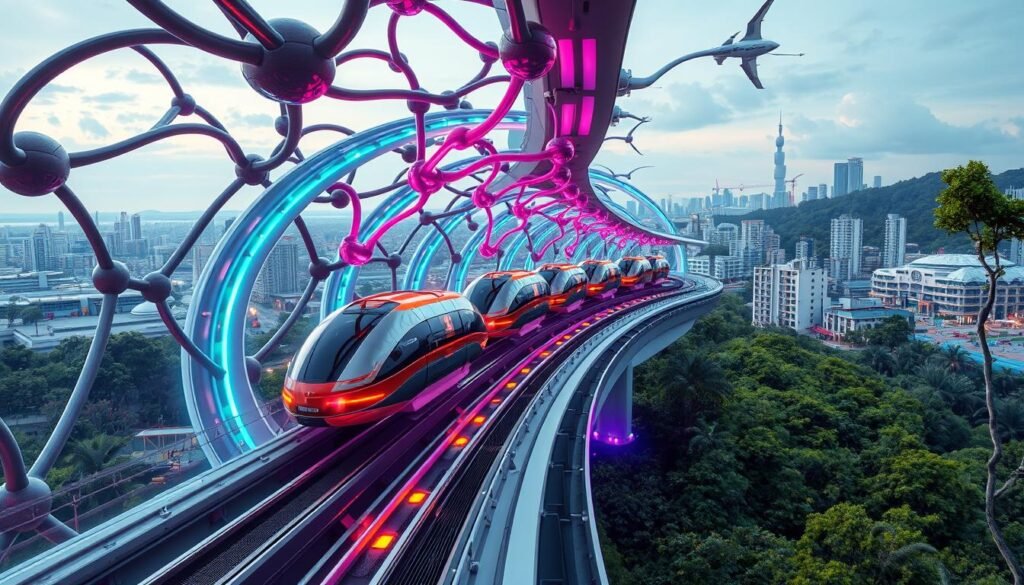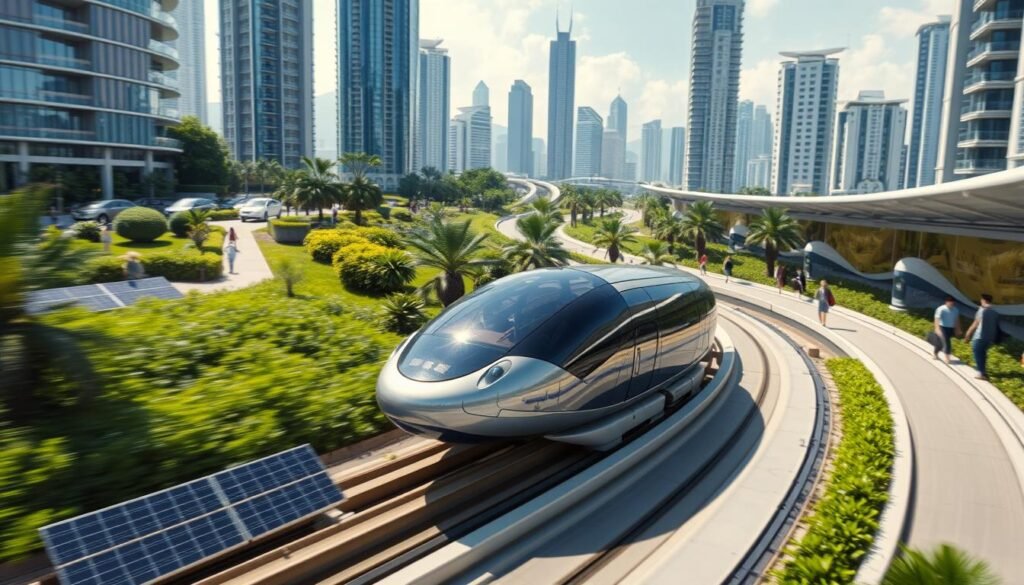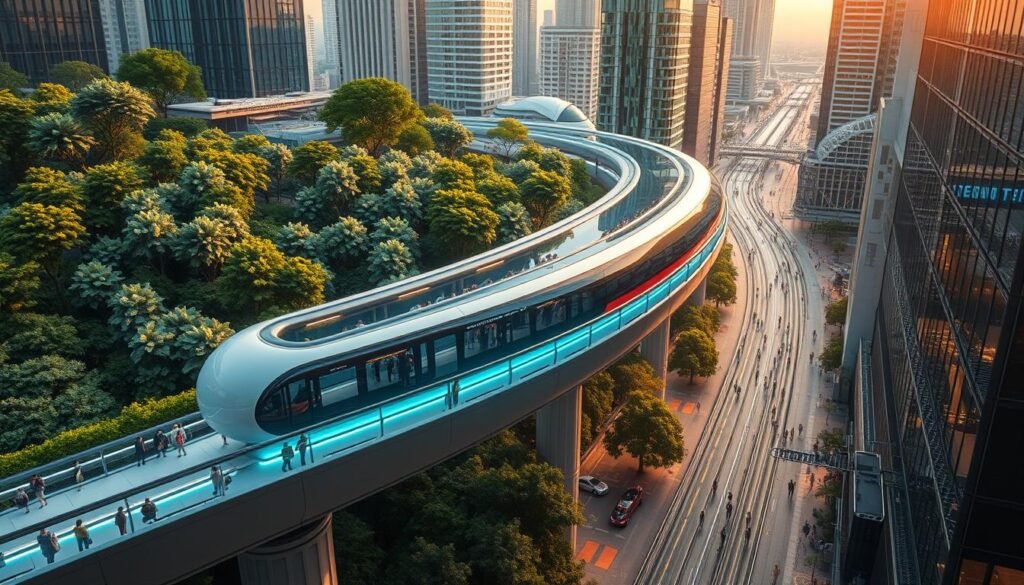By 2050, the United Nations says 68% of the world’s people will live in cities. This means we need new ways to get around. The Hyperloop is one such solution. It uses magnetic forces to push capsules through tubes at up to 1200 km/h. This makes it fast, quiet, and good for the environment.
It’s also a smart way to travel, thanks to machine learning and artificial intelligence. These technologies help the Hyperloop run better and more efficiently.

The Hyperloop is not just quick; it’s also kind to the planet. It’s a greener choice than many other ways to travel. If you’re looking for a better way to get around, consider the Hyperloop neural clustering system. It uses advanced tech to make travel smoother and more eco-friendly.
Key Takeaways
- The Hyperloop system can reach speeds of up to 1200 km/h, making it faster than other modes of transportation.
- The system uses electromagnetic forces to propel capsules through low-pressure tubes, reducing emissions and noise.
- Hyperloop neural clustering technology leverages machine learning and artificial intelligence to optimize its operations.
- The Hyperloop system is energy-efficient, with low emissions, making it a more sustainable option.
- By 2050, 68% of the world’s population is expected to live in urban areas, driving up the demand for innovative transportation solutions like the Hyperloop.
- Hyperloop neural clustering has the potential to transform the way you travel, making it an attractive option for those looking for a sustainable and efficient way to travel.
Understanding Hyperloop Neural Clustering Technology
To understand Hyperloop Neural Clustering, we need to look at its main parts. The Hyperloop system has a tube that connects two stations. This tube is mostly empty, which helps the capsule move faster and use less energy.
The system uses neural clustering, a machine learning method. It helps the system learn and get better with data analysis and pattern recognition. Deep learning is also used to make real-time changes and improve performance.
The system has capsules, tubes, and a propulsion system. Capsules travel fast, and tubes are empty to cut down air resistance. The propulsion system uses magnets to push the capsules. Machine learning and data analysis help make the system more efficient and comfortable for passengers.
The use of deep learning and pattern recognition lets the system handle different situations. This ensures a safe and efficient trip. As more people move to cities, the need for fast and green travel like the Hyperloop will keep growing.
The Revolutionary Impact on Speed and Efficiency
The Hyperloop system is changing how we travel. It can go very fast and use less energy. It uses advanced algorithms to find the best route and cut down travel time. This makes it a great choice for those who want to travel sustainably and efficiently.
This system is more efficient than old ways of traveling. It uses less energy and makes fewer emissions. Thanks to big data analytics, it can adjust to traffic changes, making your trip smoother. Building the Hyperloop costs $6-$7.5 billion, which is much less than the California rail project’s $68.4 billion.
Some key benefits of the Hyperloop system include:
- Average speed of 598 mph, compared to 164 mph for the California rail project
- Cost of a one-way ticket from LA to SF: $20, compared to $105 for the California rail project
- Expected pressure inside the Hyperloop tube: 0.015 psi, ensuring a safe and efficient journey

Experts like Marco Villa and Patricia Galloway are guiding the Hyperloop project. They make sure it’s well-planned and done right. With a trip from Los Angeles to San Francisco in about 35 minutes, the Hyperloop is changing travel. It’s faster, more efficient, and better for the planet.
Implementation of Hyperloop Neural Clustering in Modern Transit
Adding Hyperloop Neural Clustering to modern transit is a big task. It needs careful planning and action. Neural networks and machine learning help the Hyperloop system. It can make travel faster, more efficient, and better for the environment.
Some main benefits of using Hyperloop Neural Clustering include:
- Smart route optimization, reducing travel time and energy consumption
- Real-time traffic management, reducing congestion and improving travel times
- Passenger flow prediction, allowing for more efficient use of resources
Machine learning algorithms help the Hyperloop system learn from data. It can predict passenger demand. This makes travel smoother and more efficient, reducing the need for different transportation modes.
As Hyperloop technology grows, it will change how we travel. It will make travel faster, more efficient, and better for the planet. It could also help people move from cities to suburbs, improving business and reducing the need for remote work.
Transforming India’s Transportation Landscape
Thinking about India’s future in transportation? Hyperloop neural clustering is key. It could change travel for the better, making it quicker, more efficient, and green. Artificial intelligence helps make routes better, cuts down travel time, and makes trips more enjoyable.
Hyperloop neural clustering in India brings many benefits:
- Shorter trips between big cities
- Boosts the economy with better connections
- Offers a comfy and easy travel experience
Studies show artificial intelligence and transport together can make big strides. For instance, searching for “artificial intelligence” AND “transport” found 873 papers. As India builds its transport system, using hyperloop neural clustering and AI is vital.

Let’s dive into some numbers to see hyperloop neural clustering’s potential:
| Search Terms | Number of Papers |
|---|---|
| “artificial intelligence” AND “transport” | 873 |
| “transport” AND “smart city” | 594 |
| “artificial intelligence” AND “smart city” | 201 |
Conclusion: The Future of Connected Transportation
The Hyperloop Neural Clustering system is getting better, bringing new ideas to how we travel. It uses machine learning and artificial intelligence to make travel faster, more efficient, and green.
The Hyperloop is much cheaper than other projects, costing $6-$7.5 billion. This is a big difference from the $68.4 billion for the California rail project. It also goes much faster, at 598 mph compared to 164 mph.
Traveling from Los Angeles to San Francisco on the Hyperloop will cost just $20. This is a lot cheaper than the $105 on the California rail project. The Hyperloop’s advanced tech, like its battery systems and pressure control, makes it possible to travel this distance in 35 minutes.
This speed and efficiency could change how we travel and commute. It could make our trips better and reduce harm to the environment.
FAQ
What is the Hyperloop Neural Clustering system?
The Hyperloop Neural Clustering is a new way to travel. It can go up to 1200 km/h, which is faster than any other way. It uses special forces to move capsules in tubes, making it green and efficient.
How does the Hyperloop Neural Clustering system work?
It uses a smart learning system to get better over time. The system has capsules, tubes, and a special push system. Capsules go fast, tubes are empty to cut down air resistance, and the push system uses forces to move them. The learning part helps use less energy and travel better.
What are the benefits of the Hyperloop Neural Clustering system?
It’s going to change how we travel. It’s fast, uses less energy, and is good for the planet. It uses smart tech to find the best routes and cut down travel time. It’s better than old ways of traveling because it’s greener and more efficient.
How can the Hyperloop Neural Clustering system be implemented in modern transit?
Putting it into use needs careful planning. It can make routes better, save energy, and manage traffic. It can also guess how many people will travel, making trips smoother.
How can the Hyperloop Neural Clustering system transform India’s transportation landscape?
It could change India’s travel scene for the better. It’s fast, green, and makes traveling between cities easier. It also makes trips more comfortable and convenient.
Also Read
Page speed checker website html css javascript
